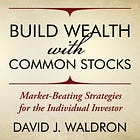Course Module 111: Weighing a Stock's Intrinsic Value
Exploring select valuation multiples of the common shares of quality enterprises

Summary
A primary tenet in the search for alpha from common stocks is determining the attractiveness of share prices based on valuation multiples relative to the fundamentals of the companies.
An appealing stock price becomes a nonnegotiable prerequisite to initiating the productive partial ownership of a quality business.
In weighing valuation, focus on the price multiples of trailing sales, earnings, operating cash flow, and the market sentiment meter of enterprise value relative to operating earnings.
Although helpful as valuation multiples, be wary of the intangibles of price-to-book ratios and the speculative projections of future growth and earnings.
Buy the common shares of targeted, high-quality, enduring enterprises when the market turns against them, thereby generating a temporary bargain price point.
A primary tenet of searching for stock investing nirvana or alpha is determining the attractiveness of a stock price based on valuation multiples relative to the fundamentals.
Successful individual investors on Main Street uncover asymmetric price/value opportunities without the need for the typical Wall Street prerequisites by targeting due diligence on key fundamental strategic areas of the business.
This course module focuses on valuation multiples—including preferred ratios—plus seven undervalued stocks of select companies in Quality Value Investing’s (QVI) Concentrated and Expanded Portfolios discovered using our proprietary matrix of present value.
Course Module 111 Syllabus
Subject matter objective: Explore select valuation metrics to analyze and weigh the intrinsic present value or margin of safety of the common shares of targeted quality enterprises.
Practicing a quality-driven valuation strategy.
Embracing the upside of market corrections and stock price capitulation.
Uncovering Quality Value Investing’s preferred intrinsic value indicators.
Seven QVI Portfolios stocks trading at attractive multiples.
The best time to buy slices of high-quality enterprises.
Module 111 voluntary action items and suggested resources.
The Quality-Driven Value Strategy
Some market pundits believe in predicting future price movements with abandon.
The proverbial crystal ball—disguised in the sophisticated clothing of technical charts, trends, and assumptions—wreaks havoc on the portfolios of unsuspecting investors modeling speculative market plays. Disciplined value investors never attempt to predict an exact stock price or the percentage changes, whether one, three, or five years from now, never mind next week.
For value-driven investors, an attractive stock price becomes a nonnegotiable prerequisite to initiating the productive partial ownership of a quality company. And the preservation of invested capital becomes supreme following the stock purchase.
In its mission to keep investing super simple, QVI relies on just four multiples serving as indicators or measurements of the potential mispricing of the stock: revenue, earnings, cash flow, and market sentiment. For entertainment, the course module also peeks at a few other more speculative multiples. In the recent volatile, albeit cash-rich, tax- and interest rate-advantaged epic bull market, companies with generous shareholder yields and high capital allocations from management were commonplace. And finding quality operators with compelling valuations remained challenging in the inflationary bear market.
A fundamental premise of this module is the potential for increasing annualized compounding total returns on capital and dividends when purchasing common shares with wide margins of safety. Savvy retail investors seek a price point below the general estimate of the company’s intrinsic value, as represented by the underlying stock.
Investors contemplating the specific stock price at any given time can save face and buy or sell speculative and risky options and futures; however, as with any casino, good luck with those house-advantaged games. Again, disciplined stock investors on Main Street refuse to interpret the Wall Street consensus as a definitive buy or sell signal. Nevertheless, evaluating the sentiment on a stock is entertaining, albeit an earnest dive into a contrarian’s treasure trove.
A confident calculation of the margin of safety provides a good measure of a company’s intrinsic worth based on recent or trailing indices as opposed to assumptive future cash flows and other crystal ball projections. Thus, gauge the present value of a targeted holding for longer-term value investing instead of shorter-term value trading.
Earn premium subscription rewards when referring friends, family, or colleagues to QVI:
Is it Sinful to Wish for a Market Correction?
Thoughtful investors follow the glorified quarterly Wall Street game of hit or miss to discover valuation opportunities in the stocks of quality companies.
To paraphrase Warren Buffett, ‘The overactive investors on Wall Street are serving the patient investors on Main Street.’
Conscientious investors never wish for a macro or microeconomic event to affect jobs and portfolios negatively. Unfortunately, when one occurs, any available dry powder gets allocated to the discounted stock prices of quality companies that often ensue. One cannot change history, just one’s reaction to it. Stick to the basic tenet of the value-driven investor’s search for alpha by focusing on a stock’s attractiveness based on valuation metrics relative to the underlying fundamentals of the business.
Market Consensus
The market consensus estimates the combined unanimity on a stock by analysts, bloggers, portfolio managers, retail investors, and employees or internal customers. Contrarians assume the crowd is wrong regarding the company’s longer-term prospects. Although additional research is necessary to confirm or contradict the accord, the consensus is often a counterintuitive indicator for thoughtful investors.
QVI’s Preferred Intrinsic Value Indicators
The QVI Portfolios contain companies trading on major US exchanges—none are micro-caps or over-the-counter issues— meeting initial quality tests such as a competitive value proposition, Treasury-beating shareholder yields, management effectiveness, and acceptable levels of downside risk.
As essential, the representative stocks were trading at sensible prices per the preferred valuation multiples at the time of purchase. Primary tickers held in the portfolios or on a watchlist are subject to further research to verify which companies, if any, are worthy of initial or continued partial ownership.
Consider an investment strategy combining quality and value as the best opportunity to generate compounding total return over an extended holding period. Here are the preferred valuation multiples used to build and monitor the QVI Portfolios.
After reading the required disclosures and background information, we’ll continue uncovering how to weigh select valuation multiples and present seven companies in the QVI Expanded Portfolio with high-quality business models that are currently trading at attractive valuations. Course Module 111 concludes with action items and suggested resources.
Disclosure: I/we have beneficial long positions in the common shares of all 18 companies represented by the QVI Concentrated Portfolio in our family portfolio.
I wrote this course myself, and it expresses my own opinions. I am not receiving compensation for it other than from Substack paid subscriptions. I have no business relationship with any company whose stock is mentioned in this module.
Disclosure: David J. Waldron’s Quality Value Investing course modules, research reports, and model portfolios are for informational purposes only. The accuracy of the data cannot be guaranteed. Narrative and analytics are impersonal, i.e., not tailored to individual needs nor intended for portfolio construction beyond his family portfolio, which is presented solely for educational purposes. David is an individual investor and author, not an investment adviser. Readers should always engage in their own research or due diligence and consider (as appropriate) consulting a fee-only certified financial planner, licensed discount broker/dealer, flat fee registered investment adviser, certified public accountant, or specialized attorney before making any investment, income tax, or estate planning decisions.
About the Writer
David J. Waldron is the contributing editor of Quality Value Investing, and author of the international-selling book Build Wealth with Common Stocks: Market-Beating Strategies for the Individual Investor. David’s mission is to inspire the achievement of his readers’ financial goals and dreams. His work has been featured on Seeking Alpha, TalkMarkets, ValueWalk, MSN Money, Yahoo Finance, QAV (Australia’s #1 Value Investing Podcast), Money Life with Chuck Jaffe, LifeBlood with George Grombacher, The Acquirer’s Multiple, Amazon.com, Barnes & Noble, Apple Books, the BookLife Prize, and Publisher’s Weekly. David received a Bachelor of Science in business studies as a Garden State Scholar at Stockton University and completed The Practice of Management Program at Brown University.
Bonus: Founding Subscribers of QVI on Substack are eligible to receive a personalized complimentary copy of the case laminate hardcover edition of the book from the author.
Let’s dig into QVI’s checklist of preferred valuation multiples plus seven quality stocks trading at attractive present values.
Keep reading with a 7-day free trial
Subscribe to Quality Value Investing to keep reading this post and get 7 days of free access to the full post archives.






